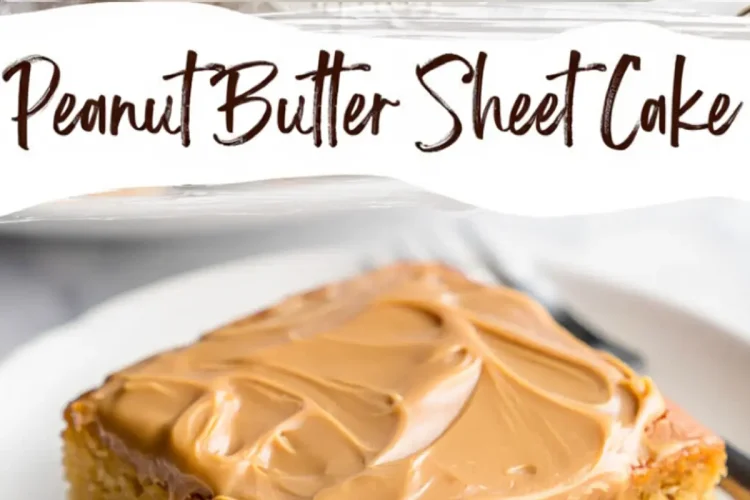Every baker needs a few recipes that never fail. This peanut butter sheet cake has earned that spot in my kitchen. You get soft, tender cake with a bold peanut butter flavor, all made in one pan. I have served it for birthdays, weekend gatherings, and casual Sunday afternoons. It wins people over every time.
You will learn how to make this cake effortlessly. I will guide you through each step and share my notes from countless batches. By the end, you will feel ready and confident to serve it for any occasion.

Why This Peanut Butter Sheet Cake Works
Peanut butter creates both the structure and flavor here. Unlike many cakes that add peanut butter only to the frosting or filling, this one builds the flavor right into the batter.
The hot mixture of peanut butter, butter, and water melts together smoothly. This process prevents clumps and blends the fat evenly throughout the cake, which gives you that soft, even crumb every time.
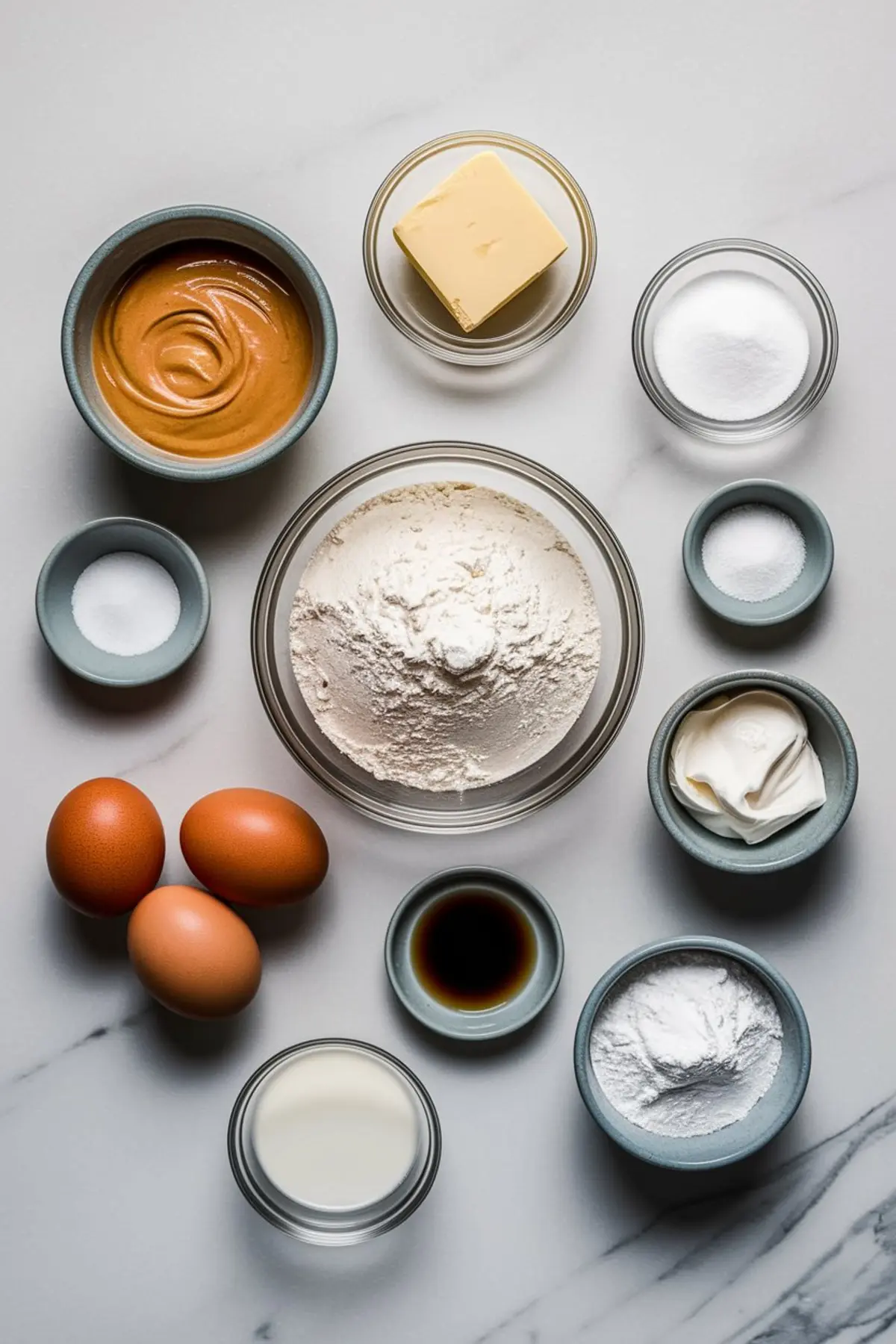
Sour cream adds moisture and a subtle tang. I have tested both sour cream and plain Greek yogurt. Both work well, but I personally lean toward Greek yogurt for its thicker body and extra protein, which creates a slightly sturdier texture without losing tenderness.
Preparing the Peanut Butter Mixture
Start with a medium saucepan. Add creamy peanut butter, unsalted butter, and water. Heat gently and stir constantly. Once everything melts into a smooth liquid, remove it from heat and let it cool for a few minutes.
I always use commercial creamy peanut butter. The natural kinds tend to separate, which affects the texture. You want that smooth, stable consistency that commercial brands deliver.
Mixing the Dry Ingredients

In a separate large bowl, whisk together flour, granulated sugar, baking soda, and salt. The sugar disperses evenly through the flour, which helps prevent sinking pockets of sweetness in the finished cake.
Keep your whisk moving for even distribution, but there is no need for sifting.
Combining Wet and Dry
Pour the slightly cooled peanut butter mixture into the dry ingredients. I use a sturdy spatula or wooden spoon here. Stir gently until you see no streaks of flour.
This step sets the foundation for the batter’s structure. Overmixing can lead to a denser cake, so aim for combined, not beaten.
Adding Eggs and Sour Cream
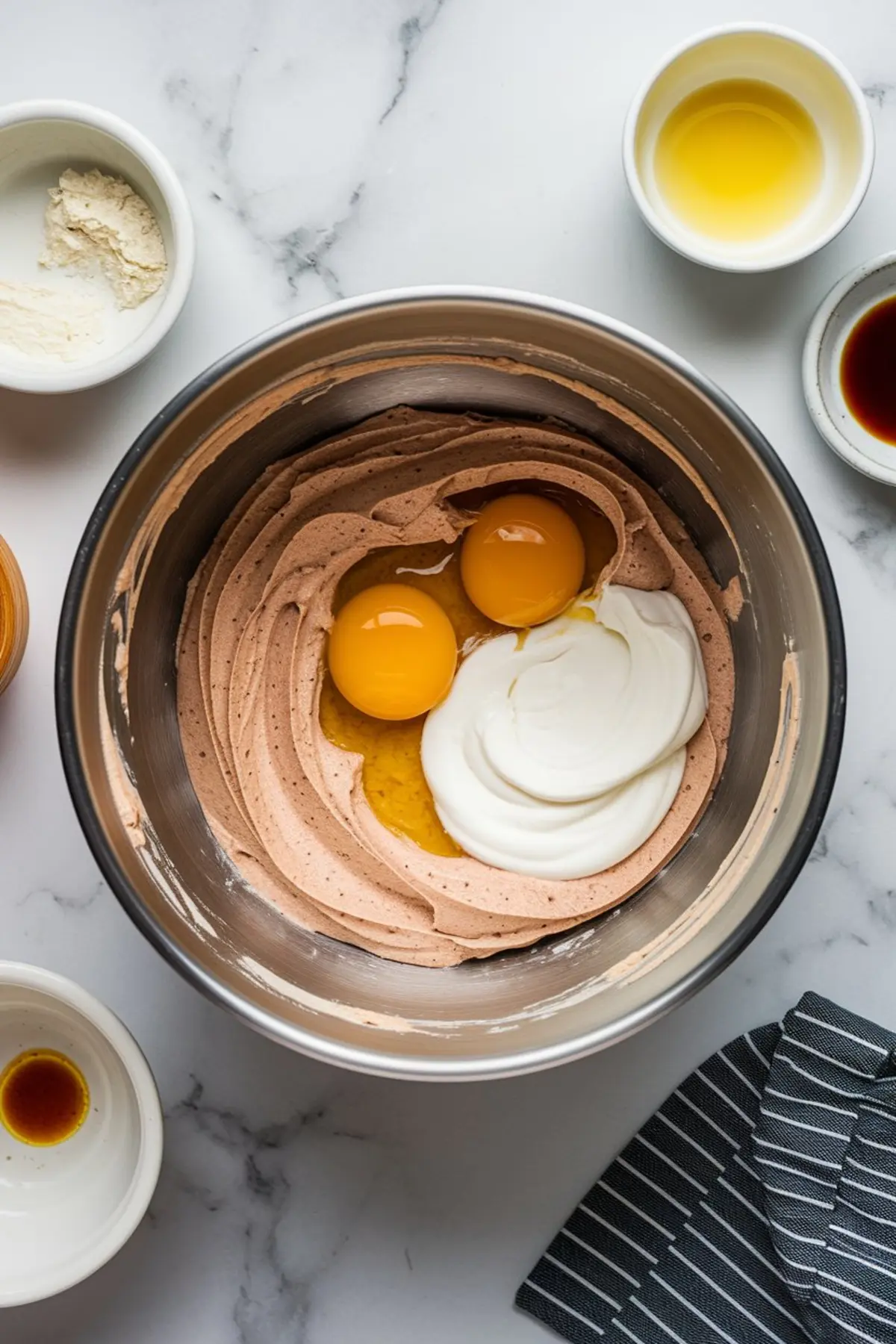
Add the sour cream (or Greek yogurt), eggs, and vanilla extract. Stir again until the batter looks smooth. This second mixing stage incorporates air while stabilizing the mixture with the richness of eggs and dairy.
I have found that this two-stage method reduces the risk of overworking the gluten, which keeps the cake light.
Baking the Peanut Butter Sheet Cake
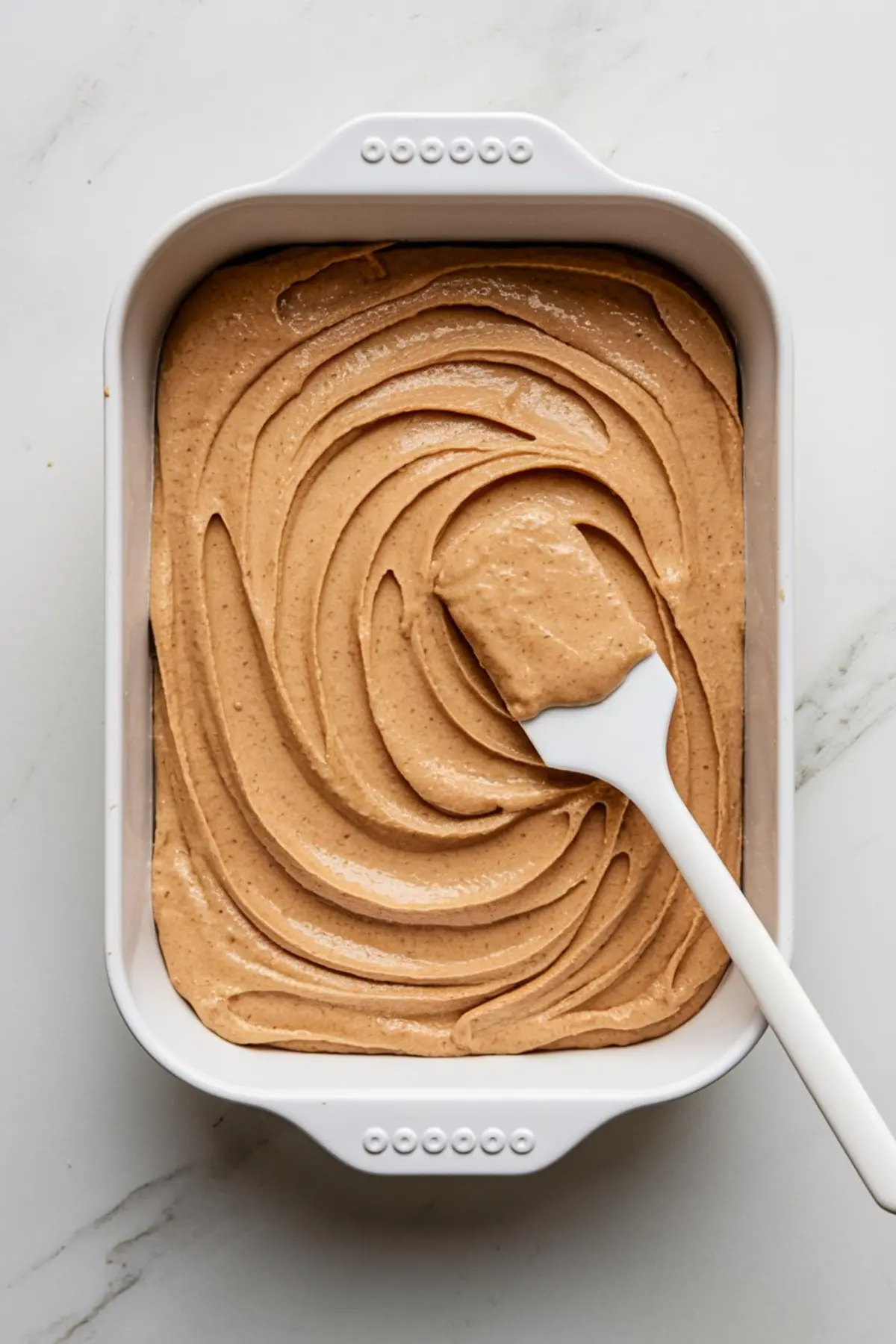
Pour the batter into a greased 9×13-inch sheet pan. Smooth the top gently. Place it in a 350°F oven.
The baking time runs about 22 to 26 minutes. In my kitchen, 24 minutes tends to hit the mark. Check with a toothpick inserted in the center; it should come out clean with a few moist crumbs.
Remove from the oven and let the cake cool in the pan for 10 to 15 minutes. This brief cooling allows the structure to set without drying out.
Preparing the Peanut Butter Frosting
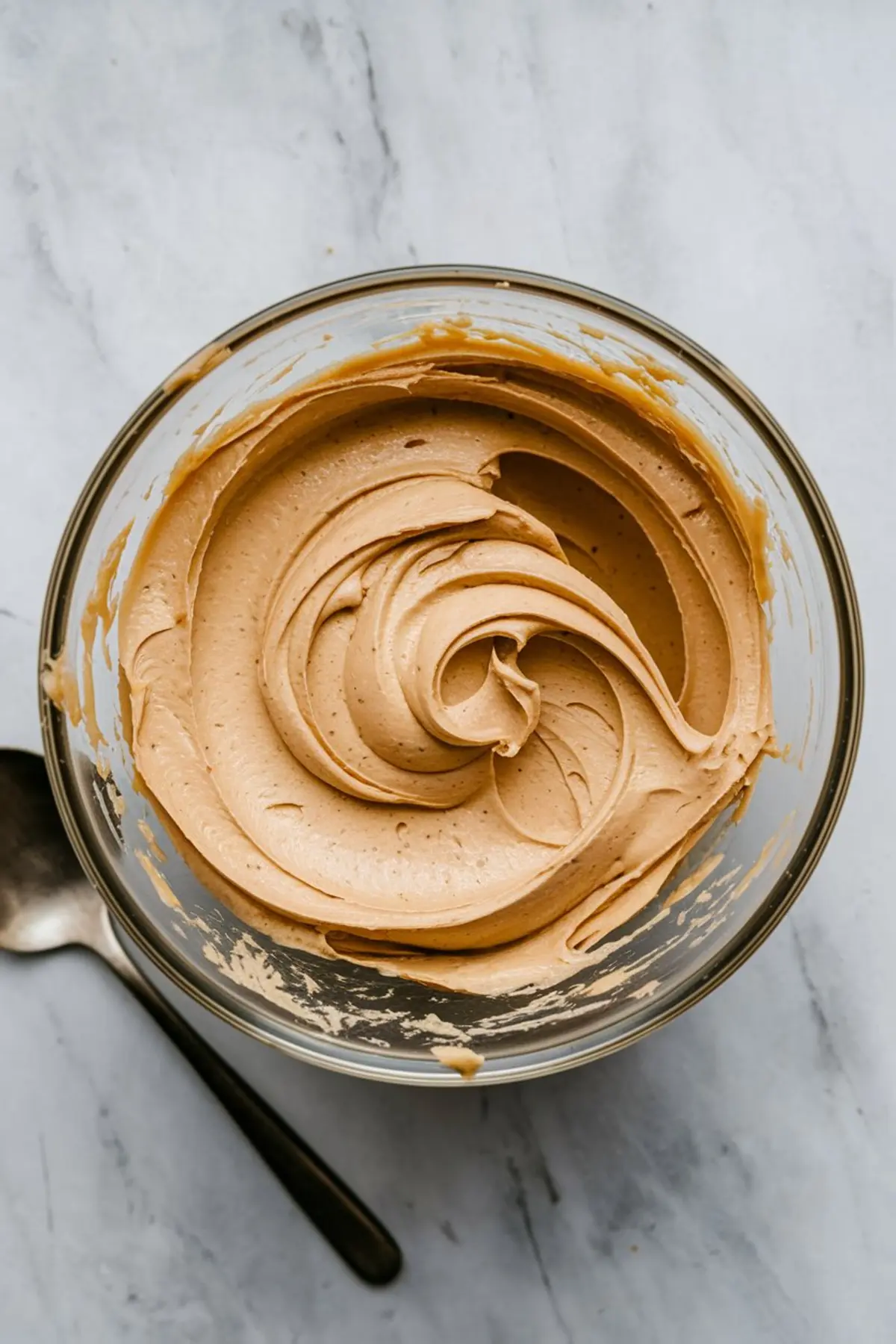
While the cake cools, beat together creamy peanut butter and softened unsalted butter until the mixture turns fluffy and light. This creates the smooth base for the frosting.
Add milk and vanilla extract. Beat again to blend. Then slowly add powdered sugar, about half a cup at a time, mixing after each addition.
The gradual addition prevents lumps and helps you control the consistency. If the frosting feels too thick, a tablespoon of extra milk brings it back to spreading consistency.
See also: How to make Peanut Butter Frosting
Frosting the Cake
Spread the frosting over the still-warm cake if you want a glossy finish that melds slightly into the surface. For a thicker layer with clean edges, wait until the cake cools completely before frosting.
Both approaches work well. Personally, I prefer frosting while the cake is slightly warm because it softens the top layer just enough to create a smooth, shiny finish.
Serving and Storing Your Peanut Butter Sheet Cake
You can serve this cake as soon as the frosting sets. It slices easily into clean squares, making it ideal for potlucks or casual gatherings.
Store leftovers in an airtight container at room temperature for up to three days. If your kitchen runs warm, refrigeration extends the freshness. Bring it to room temperature before serving again to restore its soft texture.
Helpful Comparison: Sour Cream vs. Greek Yogurt
I have tested both extensively. Sour cream produces a slightly softer, more tender crumb with a mild tang. Greek yogurt offers a firmer structure and holds up better if you plan to transport the cake. Both deliver excellent results, but if your cake needs to travel, Greek yogurt has a slight edge.
More Cake Ideas You May Love
For more celebration-worthy sheet cakes, you might also try my Simple Birthday Cake for a classic option.
If you want to explore different flavors, check out my Chocolate Sheet Cake or the elegant Pistachio Chocolate Sheet Cake. Each one offers a unique twist, but they share the same easy approach.
Pin This Peanut Butter Sheet Cake and Join the Conversation

Save this recipe to your Peanut Butter Desserts or Easy Sheet Cake Recipes board so you can always find it when you need a foolproof dessert.
I would love to hear how your cake turns out. Drop a comment below to share your results or ask any questions you have. Let’s build this baking community together.
Peanut Butter Sheet Cake Recipe
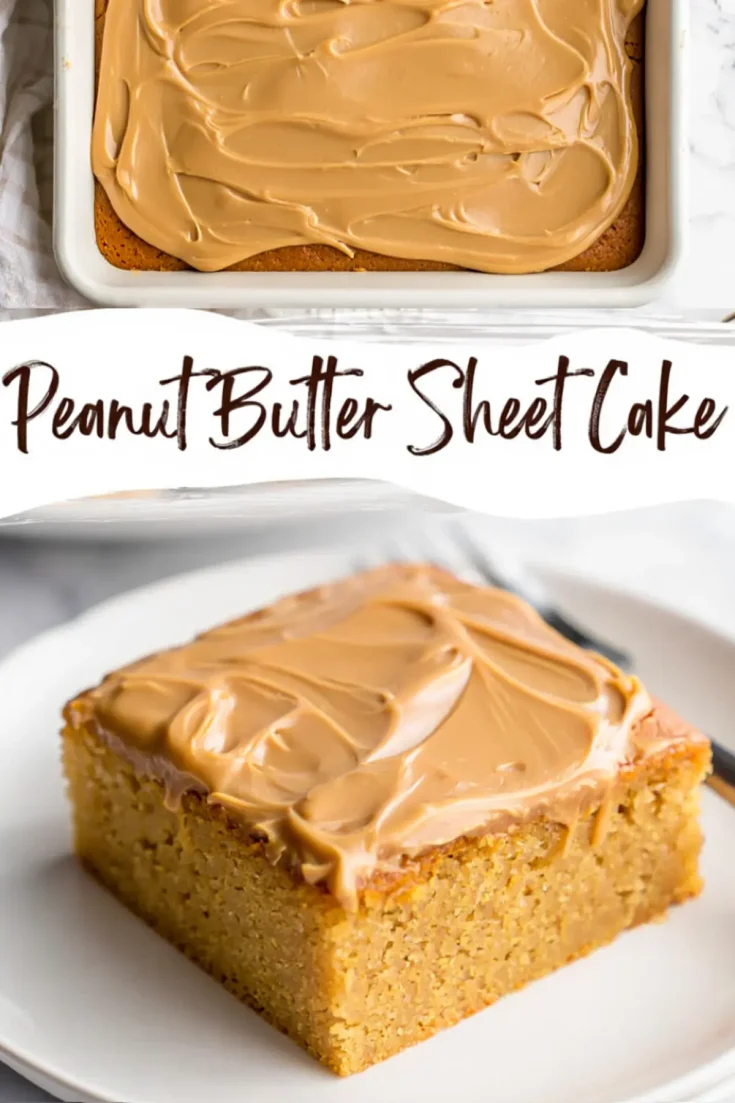
A rich peanut butter sheet cake made in one pan and topped with a smooth, creamy peanut butter frosting. This easy dessert delivers soft texture and bold peanut butter flavor with simple pantry ingredients. Great for potlucks, birthdays, or casual weekend baking.
Ingredients
- FOR THE CAKE
- 1 cup creamy peanut butter (not natural-style)
- 1 cup unsalted butter
- 1 cup water
- 2 cups all-purpose flour
- 1 ¾ cups granulated sugar
- 1 teaspoon baking soda
- ½ teaspoon salt
- ½ cup sour cream or plain Greek yogurt
- 2 large eggs
- 1 teaspoon vanilla extract
- FOR THE FROSTING
- ¾ cup creamy peanut butter
- ½ cup unsalted butter, softened
- ¼ cup milk (whole or 2%)
- 2 teaspoons vanilla extract
- 2 ½ cups powdered sugar, sifted if lumpy
Instructions
- PREHEAT THE OVEN: Set your oven to 350°F (175°C). Grease a 9x13-inch sheet pan or line it with parchment paper and set aside.
- MAKE THE PEANUT BUTTER MIXTURE: In a medium saucepan, combine the peanut butter, butter, and water. Heat over medium, stirring often, until the mixture is fully melted and smooth. Remove from heat and let it cool slightly.
- MIX DRY INGREDIENTS: In a large mixing bowl, whisk together the flour, granulated sugar, baking soda, and salt until well combined.
- COMBINE WET AND DRY: Pour the slightly cooled peanut butter mixture into the bowl with the dry ingredients. Stir gently with a spatula or wooden spoon until just combined and no flour pockets remain.
- ADD EGGS AND SOUR CREAM: Add the sour cream, eggs, and vanilla to the bowl. Stir until the batter is smooth and evenly mixed, without overmixing.
- BAKE THE CAKE: Pour the batter into the prepared pan, smoothing the top with a spatula. Bake for 22 to 26 minutes, or until a toothpick inserted in the center comes out clean.
- COOL SLIGHTLY: Remove the cake from the oven and let it cool in the pan for 10 to 15 minutes before frosting.
- MAKE THE FROSTING: In a large mixing bowl, beat the peanut butter and softened butter together until creamy and well blended.
- ADD MILK AND VANILLA: Pour in the milk and vanilla extract, then mix again until smooth.
- INCORPORATE POWDERED SUGAR: Gradually add the powdered sugar, about ½ cup at a time, mixing well after each addition. Beat until the frosting is fluffy and spreadable. Adjust with more milk or powdered sugar if needed to reach your desired consistency.
- FROST THE CAKE: Spread the frosting evenly over the still-warm cake for a glossy finish, or wait until the cake is completely cool for a more defined layer.
Notes
Use commercial creamy peanut butter for best results—natural-style peanut butter can separate and affect the texture. For a slightly tangier flavor, Greek yogurt can be used in place of sour cream. The frosting can be made ahead and stored in the refrigerator; bring to room temperature and re-whip before using if needed.
Nutrition Information
Yield
16Serving Size
1Amount Per Serving Calories 587Total Fat 35gSaturated Fat 15gTrans Fat 0gUnsaturated Fat 16gCholesterol 77mgSodium 316mgCarbohydrates 63gFiber 2gSugar 45gProtein 10g

